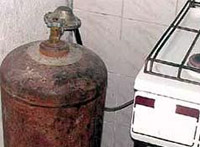It is more than one month that the stations of “Gosh Gas” don’t have gas. The other gas stations that have gas are selling it at higher prices, which are expensive by 70-80%.
One month ago the price of one kilo gas offered by gas stations was 330-350 dram, but now it has increased up to 500-600 dram. It has happened before too and when there was no gas in the gas stations of “Gosh Gas” the other stations used the opportunity to increase the prices. Such situations lasted as long as the stations of “Gosh Gas” did not have gas. Such situations happened periodically and about 4-5 times a year, however they did not last long but several days. However, now you can buy gas, for instance from the gas machine parked not far from Lambada bridge, at 600 dram for one kilo. The mobile vehicles, which sell gas and serve people by phones, sell gas at 500-600 dram too. We asked the head of the commission on protection of economic competition, Ashot Shahnazaryan whether such increase is not considered as anti-competition action in the market since the other companies use the opportunity to increase the prices. “Liquid gas is not important to me since a few number of people are using it,” said Mr. Shahnazaryan, “During the recent years the level of gasification is growing and in parallel with that the demand for liquid gas is falling down. Besides that, there are few cars, which use liquid gas. Most of the cars are using pressed gas. However, we have asked and were informed that the gas is on the way to Armenia and is coming. It may be delayed for one or two days”. We don’t agree with Mr. Shahnazaryan because those citizens, who don’t have natural gas, are using liquid gas. According to “ArmRusGazard”, 490.000 economies out of the existing 700.000 ones in Armenia are gasified. It means that 210.000 economies, or 25-30% of the total number don’t have natural gas and are using liquid gas. It turns out that the sellers of liquid gas are using their opportunity and are making super-profits on the expense of these 210.000 economies. As for Mr. Shahnazaryan, he says “it is not important to him”. Yesterday we were informed by “Gosh Gas” company that they did not have gas. They told us to call in 3-4 days. This is the answer they have been giving this month. Recently the customs committee made a statement, according to which the liquid gas capacity imported in October was equal to that in each of the previous months. On the other hand, as Mr. Shanazaryan says, in parallel with gasification the demand on liquid gas is falling. It seems that there should not be any deficit since the median demand has been satisfied. There are many contradictions in the existing situation. In the existing situation we may only think that such artificial deficit is not a result of lack of liquid gas, but a result of re-allocation of capacities in the market. It is not a secret that “Gosh Gas” belonged to the former head of the operative investigation department of the taxation services, Shahen Hovasapyan, who was killed near his house last year in September. Now his business is managed by his brother. According to our information, after this murder the state bodies are not so “courteous” about the businesses of Hovasapyan’s family. The high rank official of the taxation body had several businesses. It is clear that due to being a high rank official he didn’t have any problems with the taxation and customs services. Now, due to certain reasons, Hovasapyan’s brother cannot administer the businesses with the same skills as his brother did. According to our information, even the taxation services have “attacked” his businesses. It is seen from the tax incomes of that business. If in the period of January-September, 2006, “Gosh Gas” paid 111,5 mln dram, during the same period of this year it paid 122,5 mln dram. It will not be exaggerated if we say that during this year “Gosh Gas” did not have gas for about two months. The company hasn’t been faced with such situation during the previous years. However, the company has increased its financial inflows in such difficult conditions. Thus, we may assume that after Hovasapyan was killed the company lost its umbrella and started to cut the share of its shady activity. In September it was one year since Hovasapyan was killed, and in October his company is having crisis. The existing deficit in the market of liquid gas shows that re-allocation of business shares is happening in the market. Thus, it is not excluded that during the coming years “Gosh Gas” may generally disappear from the market or, as it happens often in our days, another high rank official may become the owner of that business. It is not excluded either that the prices of liquid gas may continue growing in the future too. However, as we mentioned above, “liquid gas is not important to Mr. Shahnazaryan”.

